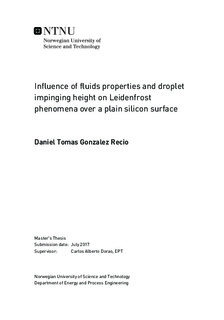Influence of fluids properties and droplet impinging height on Leidenfrost phenomena over a plain silicon surface
Master thesis
Permanent lenke
http://hdl.handle.net/11250/2461336Utgivelsesdato
2017Metadata
Vis full innførselSamlinger
Sammendrag
The need for high heat flux removal has been triggered by the development of new technologies ranging from computers, data centers, medical applications, electric cars, radars, satellite, and lasers, to mention some applications. Today it is recognized that manufacturability is not the limiting factor with regards to the small size of the devices and that major challenge is the power dissipation problem.
Spray cooling has been shown as a possible solution for cooling of high heat fluxes systems. However, the Leidenfrost phenomena pose a limitation to the use of liquid to cool down hot surfaces as it prevents the dissipation of heat. This effect consists of the development of a vapor layer that makes the impinging cooling fluid bounce away when impacting the hot surface, becoming heat dissipation ineffective. This regime is named film boiling.
The primary objective of this work is to experimentally determine the different boiling regimes and Leidenfrost point for deionized water and various dielectric fluids evaluating the influence of fluids properties and the dependence of droplet impact height over a heated plain silicon surface. Furthermore, designing and fabrication of a test section for studying impacting droplets over a plain silicon surface have been completed.
Final results show and discuss the different droplet deposition heights evaporation curves for deionized water and FC-72, boiling regimes along the deionized water and FC-72 experimental curve, Weber map showing different boiling regions and a comparison between deionized water and FC-72 performance.
